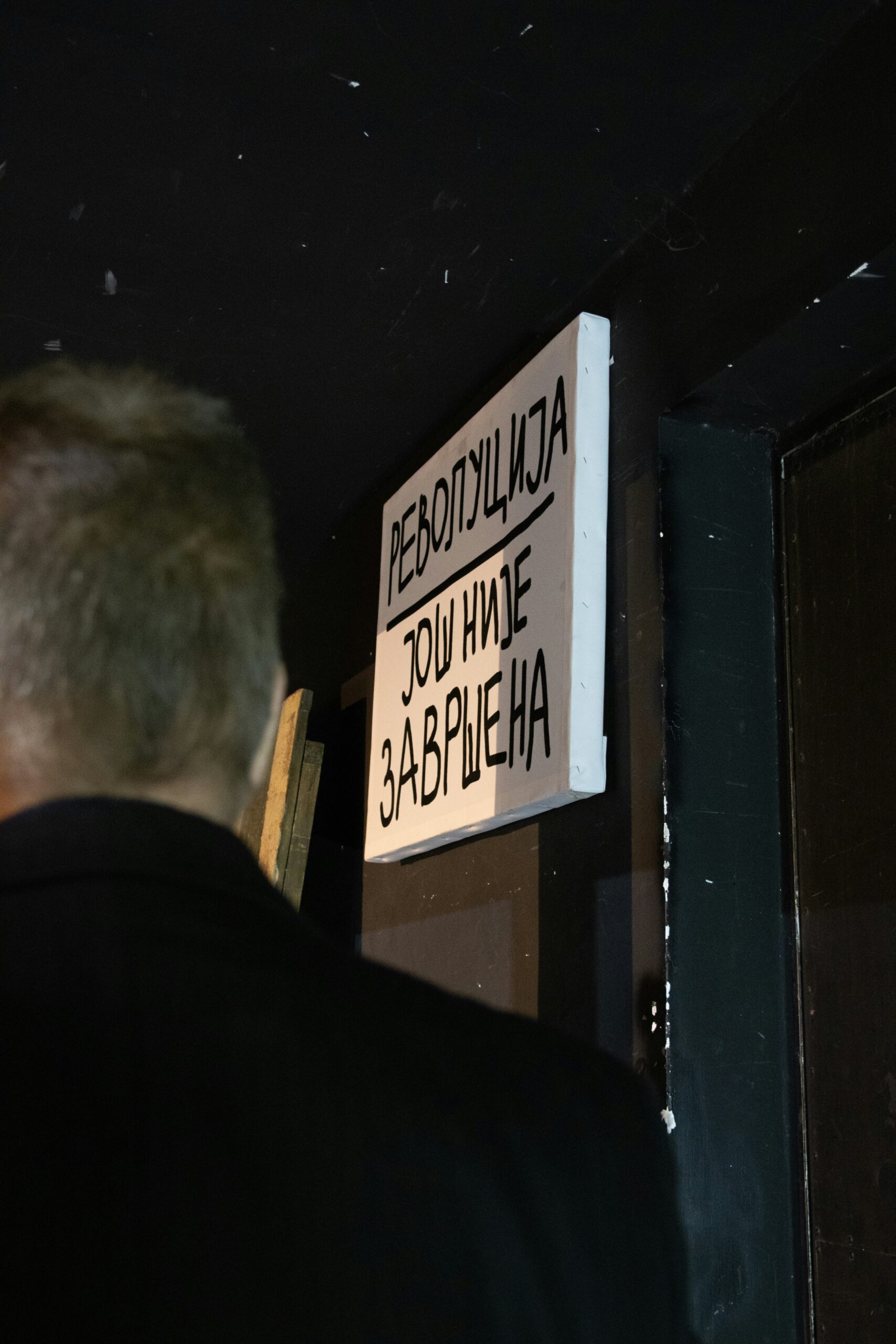Introduction to Belgrade’s Protests
The recent protests in Belgrade represent a significant response to the myriad social, political, and economic challenges that have plagued Serbia in recent years. Underlying these demonstrations is a complex web of dissatisfaction among diverse segments of society, driven by concerns regarding governance, corruption, and the overall economic state of the nation. The origins of these protests can be traced back to historical grievances; Serbia’s past is marked by tumultuous political transitions and persistent economic hardships, which have often fueled collective action among its citizens.
In particular, the escalation of discontent began to surface prominently in late 2022 and early 2023, as citizens voiced their opposition to various governmental policies and actions. Issues such as inadequate healthcare, rising unemployment rates, and perceived government inaction concerning infrastructural development have significantly strained the trust of the populace in their officials. This environment of frustration has made it fertile ground for protests to emerge. Furthermore, the increasingly vocal demands from civil society regarding human rights and environmental concerns have added layers of complexity to the motivations behind these protests.
Historically, Serbia has a rich tradition of protest movements, from the 1968 student protests against the government to the 2000 protests that led to the ousting of the then-president Slobodan Milošević. Each of these movements has contributed to a broader discourse about democracy, freedom, and accountability in Serbian society. As the current protests unfold, they not only reflect a continuation of this historical discourse but also resonate with the urgent calls for change in response to contemporary issues. Understanding the context in which these protests arise is crucial for comprehending their significance, as they highlight the ongoing struggle for a democratic and just society in Serbia.
Historical Context of Protests in Serbia
The history of protests in Serbia is deeply intertwined with the country’s turbulent political landscape, particularly following the fall of Yugoslavia in the early 1990s. This period marked a significant turning point, as the disintegration of the federation gave way to new national identities and a struggle for political control. The transition from a socialist regime to a multi-party democracy was anything but smooth, often leading to widespread civil unrest.
One of the earliest significant protests occurred in 1996-1997 in response to electoral fraud during local elections in Belgrade. This movement, known as the “Zajedno” protests, saw a coalition of opposition parties unite against the authoritarian rule of Slobodan Milošević. The protests highlighted citizens’ demand for democracy, transparency, and civil rights amidst a backdrop of widespread disillusionment with the political elite.
As the 1990s progressed, Serbia experienced not only political turmoil but also ethnic conflicts, particularly in Kosovo. The NATO intervention in 1999 and subsequent political developments intensified societal divisions. In 2000, a series of mass protests led to the ousting of Milošević, representing a pivotal moment in Serbia’s fight for democratic governance. This change, however, did not eradicate the tradition of protests. The years that followed saw various demonstrations addressing diverse issues, from economic hardship to governmental reforms.
Fast forward to recent years, Serbia has witnessed a resurgence of civic activism. Protests were driven by dissatisfaction with the ruling government’s policies, including corruption, media freedom, and environmental concerns. Notable movements, such as the “1 of 5 Million” protests between 2018 and 2019, epitomized a growing frustration among citizens. These events reflect an ongoing struggle between the populace’s aspirations and the political class, underscoring how deeply rooted the culture of protest is in Serbia’s historical narrative.
Key Issues Driving the Protests
The recent protests in Belgrade, Serbia, are driven by several pressing grievances that have resonated deeply with the population. Foremost among these is a pervasive sense of corruption within various levels of government, which has eroded public trust in institutions. Many citizens feel that government officials are engaged in nepotism and favoritism, resulting in an unequal distribution of resources and opportunities. This widespread discontent over corruption serves as a rallying point for those who demand integrity and accountability in governance.
Additionally, political accountability is a significant issue fueling discontent among protestors. Many Serbs believe that their voices are often ignored by those in power, leading to a growing chasm between the government and the populace. This disconnection diminishes the effectiveness of democratic processes and makes citizens feel powerless in shaping their political landscape. Protesters are demanding reforms that ensure greater transparency and responsiveness from elected officials, emphasizing the need for mechanisms that hold government leaders accountable for their actions.
Media freedom, another cornerstone issue, has come under scrutiny as well. Concerns regarding the censorship of independent journalism and the manipulation of media narratives have alarmed citizens who view a free press as essential to a healthy democracy. Restrictive measures against journalists have sparked a call for a media environment that fosters diverse opinions and uncensored reporting, which are fundamental to informed public discourse.
Environmental issues also contribute to the protests, particularly regarding urban development initiatives that threaten natural spaces and public health. Citizens are increasingly aware of the necessity to preserve their environment, advocating for sustainable practices and policies. Lastly, social inequality, highlighted by economic disparities, prompts a demand for policies that promote social justice and ensure equitable opportunities for all citizens. These interconnected issues reflect the broader struggles within Serbian society and underscore the urgency for meaningful change.
Demographics of the Protestors
The protests in Belgrade, Serbia, have garnered significant attention not only for their immediacy but also for the diverse coalition of individuals participating. Understanding the demographics of the protestors is key to grasping the broad appeal and underlying motivations of the movement. Participants range across various age groups, socioeconomic backgrounds, and political affiliations, demonstrating an unprecedented unity among the populace.
Younger generations, particularly students and young professionals, have taken a prominent role in the protests. Their involvement often stems from concerns regarding environmental sustainability, job opportunities, and the erosion of democratic values. Reports indicate that a substantial portion of demonstrators is aged between 18 and 30, highlighting their desire for a more progressive and inclusive political landscape. Additionally, older citizens have joined in solidarity, bringing their experiences of past political struggles, thereby enriching the dialogue within the movement.
The socioeconomic diversity among protestors underscores the universal discontent with current governance. Individuals from lower-income backgrounds emphasize issues such as rising costs of living and inadequate public services. Conversely, members of the middle class are motivated by a sense of disillusionment with corruption and a perceived lack of accountability among leaders. This intersection of class issues forms a significant aspect of the coalition, bifurcating traditional political spectrums and bridging gaps that often separate socio-economic groups.
Politically, the protestors encompass a wide array of affiliations, from environmental activists to anti-corruption advocates. Notably, many individuals have abandoned their party identities in favor of a collective agenda aimed at systemic change. This shift has resulted in an inclusive movement that, despite its diversity, remains united in its demand for transparency, equity, and a brighter future for Serbia. Such an amalgamation of voices signifies both a rejection of past governance and a collective wish to shape a new political narrative moving forward.
The Role of Social Media in Mobilizing Protests
In recent years, social media has profoundly reshaped the landscape of grassroots movements and protests around the world, and the recent events in Belgrade, Serbia, exemplify this trend. Platforms such as Twitter, Facebook, and Instagram have become instrumental tools for activists, enabling them to mobilize supporters, disseminate information, and raise awareness on critical issues rapidly. The immediacy of these digital platforms facilitates real-time communication, allowing organizers to plan events, disseminate location details, and coordinate actions, thereby enhancing the efficacy of protest initiatives.
A primary function of social media in the context of the Belgrade protests has been the ability to quickly galvanize public interest and participation. By sharing pertinent updates, compelling images, and firsthand accounts, users effectively engage a wider audience. Hashtags specific to the movement have emerged, becoming rallying cries that connect individuals across the nation, encouraging solidarity and collective action. This digital outreach does not only resonate locally; it also catches the eye of international observers, drawing attention to societal issues faced in Serbia.
However, the role of social media is not without its challenges. The rise of misinformation poses significant risks, as false narratives can undermine the intentions of genuine movements. Distorted facts and misleading information can spread just as rapidly as credible sources, potentially creating confusion and division among followers. Protest organizers must approach social media with a critical eye, verifying information before sharing and encouraging followers to do the same. The digital space is a double-edged sword where cooperation and vigilance are essential to ensure that the message of activism is not discredited by the spread of inaccurate data.
Government Response to the Protests
The Serbian government’s response to the recent protests has been multifaceted, reflecting a complex interplay between dialogue and repression. In the initial phases of the protests, which began in reaction to various social and economic grievances, government officials attempted to engage with demonstrators through peaceful dialogue. This approach was evident in public statements made by several ministers who called for discussions on the issues at hand, aiming to deescalate tensions and address the concerns raised by protesters. The government seemed to recognize the importance of public sentiment, particularly in an era where social media amplifies dissenting voices and mobilizes collective action.
However, as protests persisted and arguably intensified, the response shifted significantly. Instances of repression became more pronounced, with an increased police presence at protest locations. Law enforcement agencies were deployed to manage crowds, often resulting in confrontational scenarios. Reports of excessive use of force by police have circulated, raising concerns regarding the balance between maintaining public order and respecting citizens’ rights to free expression. Arrests of protestors have also been documented, with some individuals facing legal actions that many critics argue are politically motivated.
The Serbian government has publicly justified its tactics by framing the protests as a potential threat to national stability. Government officials have emphasized the need for law and order, asserting that while they respect the right to protest, they will not tolerate violence or disruptions to public safety. This narrative has enabled the government to justify a more aggressive stance against demonstrators while simultaneously portraying itself as a protector of societal norms.
This dual approach of engaging in dialogue while simultaneously enforcing a hardline stance illustrates the complexity of the Serbian government’s strategy in addressing the ongoing protests. As the situation evolves, the balance between these two methods will likely remain a focal point in understanding the government’s future actions and the protestors’ responses.
International Reactions and Media Coverage
The recent protests in Belgrade have elicited a varied response from the international community, reflecting a spectrum of concerns and perspectives. Foreign governments, particularly those within the European Union, have expressed their stance through official statements, calling for peaceful dialogue and urging local authorities to respect democratic freedoms. Countries with vested interests in the region, such as the United States, have also highlighted the importance of addressing the protesters’ grievances, emphasizing the need for a transparent and inclusive political process. This international support serves as a beacon for protesters advocating for change and reform.
In contrast, reactions from countries with differing political ideologies, such as Russia and China, have often portrayed the protests as influenced by Western agendas, attributing destabilizing motives to foreign involvement. Such narratives may deepen the divide in international perceptions of the events unfolding in Serbia, illustrating the complex interplay between national interests and global politics. The role of international organizations like the United Nations and the Organization for Security and Co-operation in Europe (OSCE) has been crucial, as they have monitored the situation while emphasizing the significance of upholding human rights standards.
Media coverage has also played a pivotal role in shaping the narrative surrounding the protests. Major international news outlets have reported extensively, providing diverse perspectives on the root causes and implications of the demonstrations. However, coverage can often vary dramatically between local and international media, leading to discrepancies in public understanding. Some media platforms have been criticized for sensationalism, which tends to overshadow the nuanced realities faced by the protesters. Others focus on highlighting grassroots voices, aiming to depict the urgency and legitimacy of the protesters’ demands. The impact of these narratives on global public opinion is profound, influencing perceptions of Serbia’s political landscape and its ongoing struggle for democracy.
Comparative Perspectives: Protests in the Region
The sociopolitical landscape of the Balkans has often been characterized by a history of unrest, encompassing a spectrum of protests that reflect the varying demands of the populace. In recent years, protests in Serbia have emerged prominently, yet they are part of a broader context of civil movements in neighboring countries such as Bosnia and Herzegovina, Montenegro, and North Macedonia. A comparative analysis of these protests reveals important similarities and differences in motivations, strategies, and governmental responses.
In Serbia, the recent protests were largely triggered by public discontent over environmental issues, government corruption, and overall democratic deficits. This mirrors the motivations seen in neighboring countries, where citizens also express dissatisfaction with governance, economic hardship, and the preservation of natural resources. For instance, the environmental protests in Bosnia and Herzegovina, stemming from similar frustrations, highlight a regional concern regarding ecological preservation and local governance.
The strategies employed by protestors across the Balkans further illustrate commonality. Demonstrations in Serbia often galvanize significant public support through social media campaigns and organized collective actions. This has been evident in North Macedonia, where citizens have mobilized through digital platforms to address both political and economic grievances. However, the specific context of each nation shapes these strategies, with local history and social dynamics influencing participant engagement.
Government responses to protests also exhibit contrasting approaches. In Montenegro, for example, state authorities have shown a tendency for negotiated resolutions amid rising tensions. On the contrary, Serbia has witnessed a more forceful crackdown on dissent, as evidenced by police actions against demonstrators. These divergent responses reflect not only national strategies but also the varying degrees of political stability and civil society engagement within the region.
By examining the protests in Serbia alongside those in neighboring nations, it becomes apparent that while there are shared experiences and struggles, each country possesses unique characteristics that inform their individual protest dynamics. This comparative perspective provides valuable insights into the ongoing evolution of civil society across the Balkans, highlighting both the commonalities and distinctions that shape the region’s sociopolitical narrative.
The Future of the Protests and Potential Outcomes
As protests in Belgrade continue to unfold, the future implications of these movements carry significant weight for the social and political landscape of Serbia. The ongoing demonstrations reflect deep-seated public discontent with governmental measures and societal issues, and they shed light on the collective demand for reform. Various potential outcomes can emerge from this unprecedented wave of activism, each contingent upon how authorities and citizens engage in dialogue and action.
One possible scenario is a governmental response that genuinely addresses the protesters’ concerns through meaningful policy changes. Such reforms could include enhanced social support systems, a revival of democratic norms, and active measures against corruption. If the government engages constructively with civic demands, this may not only quell unrest but also restore public trust, fostering a more inclusive political environment moving forward.
Conversely, if the authorities choose to resist reform and take a more authoritarian stance, the protests may intensify. This could lead to an escalation of civil unrest, potentially causing further division within society. The commitment of the population, particularly the youth, will be crucial in this context. Young people have played an instrumental role in shaping the narrative of the movement, utilizing social media platforms to rally support and disseminate information. Their active participation signals a shift in political awareness and engagement, which may force political entities to reconsider their approach.
The future of the protests embodies more than a response to immediate grievances; it represents a critical juncture in Serbian society. Continued civic engagement, alongside the mobilization of diverse societal groups, will be essential for pushing towards a future characterized by transparency and accountability. Ultimately, fostering a politically conscious citizenry could empower individuals to shape Serbia’s evolving political landscape for years to come.


